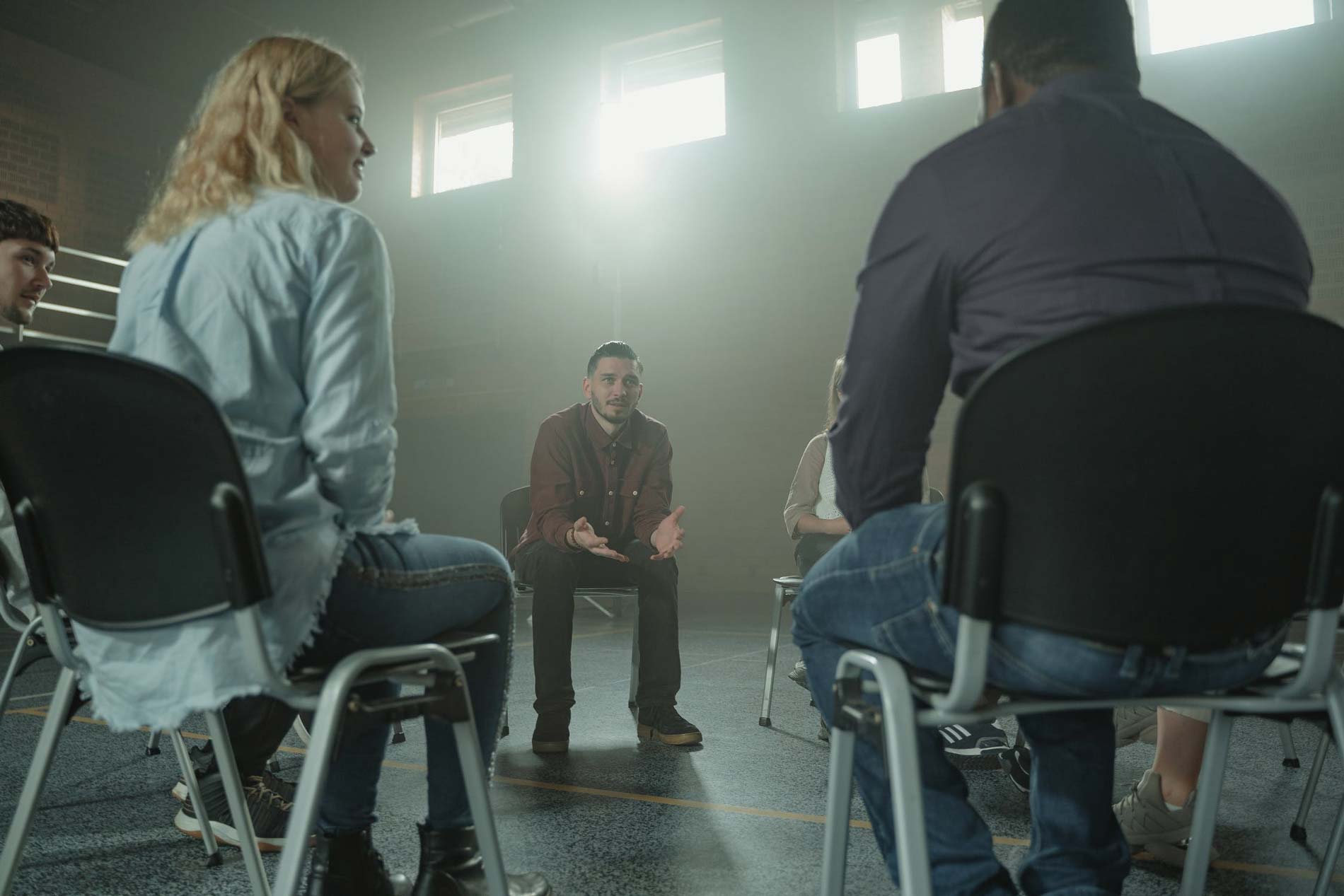Why Your Failed New Year's Resolution Deserves a Second Chance
Now that we’re one month into 2015, many of you will have thrown in the towel on your New Year´s Resolution. Some of you might not have set one at all, while others of you were going strong for the first two weeks and then “fell off the wagon” in mid-January. If you´re one of the many people who haven’t been able to stick to whatever plan you had in mind, you might be feeling “lazy,” “unmotivated” or even considering whatever resolution you had in mind to be a “lost cause.”

However, what if the fact that you weren’t able to follow through with your goals was related to where you stand in what psychologists refer to as “The Stages of Change¨ model? Would you be able to treat yourself and your supposed “failure” with a more compassionate attitude? And would you possibly consider jumping back on that wagon and starting again? Let’s take a look…
- Precontemplation: In this stage you may have heard from others that you ought to make a change, but you´re not actually considering doing anything about it.
- Contemplation: You´re considering making a change and imagining what it might be like if you did make that change.
- Preparation: You´ve started gathering information and support and are almost ready to take the first steps.
- Action: You´ve taken the first steps to put your plan into action.
- Maintenance: You´re in this stage when you have been diligent at carrying out actions that you had committed to for at least six months.
DeClemente and Prochaska’s Stages of Change Model has been largely used in the field of addictions for understanding why some people are able to stop drinking or using drugs, while others stay stuck in a standstill. Many therapists, including myself, have also found this model to be helpful when working with patients with Eating Disorders. These patients are notorious for having poor treatment outcomes, which can be really frustrating for those professionals trying to treat them, as well as the families and the patient’s themselves. However, by stepping back and asking these patients, “how ready are you to change?” the apparent resistance to treatment can be seen for what it really is: that the patient is not ready to change, yet.
And that word «yet», holds in it one of the keys to this model. It allows you to see that whatever stage you are currently at is only temporary and therefore advancing towards your goals is a matter of identifying what you need to help you increase your readiness to change and therefore advance to the next stage. Another important aspect of this model is that it normalizes «falling off the wagon.» It acknowledges that behavior change is more often than not a nonlinear process meaning we often must take «two steps forward, one step back» in order to advance towards our goals.
The Stages of Change Model is not only reserved for such serious problems as the treatment of drug addiction and Eating Disorders. It can be applied to anyone interested in making a change in their lives, whether it is to procrastinate less, go to the gym more or wake up without hitting the snooze button so many times.
What New Year’s Resolution did you set for yourself this year? Or wish you had set for yourself? Take a look at the model above and ask yourself what stage you´re at in relation to this resolution. Working with a therapist can help you to identify where you are, what is blocking you from moving forward and together you can work to create a personalized plan to help you work towards giving your New Year’s Resolution the second chance it deserves this year.
El estrés laboral: un problema generalizado. Una solución compleja
El estrés laboral es un fenómeno generalizado en nuestra sociedad que se ha acentuado aún más desde el inicio de la crisis económica. La precariedad laboral, los salarios menguantes y la perdida de empleo o el desempleo han hecho que se disparen los porcentajes de trabajadores que lo sufren.
Es verdad que cierto nivel de estrés puede ser adaptativo e incluso puede llegar a motivar, aumentar nuestro rendimiento, y conseguir que llevemos una vida más estimulante, pero muchas veces, cuando sobrepasamos este umbral, el estrés nos acaba agotando, y repercute muy negativamente sobre nuestro rendimiento y nuestra salud.
El coste económico es enorme pero generalmente las empresas o las organizaciones están poco dispuestas a tomar medidas que reduzcan sus efectos si eso implica tener que modificar sus procedimientos o pensar en el bienestar del trabajador.
Algunas de las medidas que las organizaciones podrían tomar para reducir los niveles de estrés en sus empleados están ya tipificadas:
- Establecer horarios de trabajo que eviten conflictos con las exigencias y responsabilidades externas ( en definitiva ser mas flexibles ).
- Fijar cargas de trabajo compatibles con las capacidades del trabajador y permitirle recuperarse después de periodos más exigentes.
- Permitir el uso de las capacidades personales de cada trabajador para lograr que su realización sea más estimulante.
- Evitar la ambigüedad en relación al futuro ( estabilidad laboral y el fomento de progresión laboral).
- Diseñar adecuadamente las condiciones del puesto de trabajo ( ambiente físico, capacitación adecuada ).
- Fomentar la comunicación fluida dentro del entorno de trabajo ( entre iguales y a distintos niveles ).
- Permitir la participación en la toma de decisiones.
- Definir claramente las funciones y tareas a realizar.
- Apoyar socialmente desde dentro de la organización a sus empleados.
Sin embargo, en las condiciones actuales del mercado laboral, estas medidas no dejan de ser un compendio de buenas intenciones con difícil implementación real.
¿Debemos pues renunciar a intentar vivir menos estresados en el trabajo? La respuesta es claramente no. Podemos y debemos controlar nuestros niveles de estrés a pesar de no poder contar con la plena colaboración de las organizaciones.
¿Pero, cómo hacerlo? Hemos de focalizar nuestros esfuerzos en aquello que está bajo nuestro control y sobre lo que podemos actuar: es decir, nosotros mismos.
Por último, me gustaría recomendar dos películas que aun siendo muy distintas, las dos tratan este tema y nos pueden ayudar a reflexionar sobre nuestra capacidad para modificar nuestro entorno: “¡Que Bello es Vivir!” (“It´s a Wonderful Life”)” y “Cadena de Favores” (“Pay it Forward”).
La primera es un clásico de Frank Capra, protagonizada por James Stewart y Donna Reed de 1946. En ella se cuenta la historia de un hombre que contempla cómo hubiera sido la vida de los que le rodean si él no hubiera existido…
La segunda es una película del año 2000 dirigida por Mimi Leder con Kevin Spacey y Helen Hunt que narra cómo un niño de 12 años piensa y pone en práctica un método que sirve para mejorar el mundo con la ayuda de la simple determinación y la voluntad de cada persona.
Cuando nos vemos agobiados por el trabajo, tenemos tendencia a dejar de lado toda una serie de hábitos saludables que nos protegen frente al estrés:
- ejercicio regular,
- patrón del sueño adecuado,
- alimentación equilibrada,
- relaciones sociales gratificantes y
- actividades de ocio
y por el contrario adoptamos toda una serie de hábitos negativos:
- aumenta o se inicia el consumo de tabaco, alcohol y otras sustancias nocivas para la salud,
- aumenta el consumo de medicación,
- se come en exceso
Cuando el estrés se sufre de forma prolongada, pueden incluso aparecer diversos problemas de salud como:
- dolores de cabeza
- problemas cardiovasculares
- problemas digestivos
- problemas sexuales
- agotamiento físico
- insomnio
La depresión, la ansiedad, y el debilitamiento del sistema inmunológico son también consecuencias de un estrés prolongado e intenso.
Para prevenir y tratar este tipo de problemas tenemos que hacer un esfuerzo consciente para mantener y/o mejorar nuestros hábitos de salud general. Pero además de estos hábitos, podemos mejorar nuestros recursos y aprender nuevas habilidades para el manejo del estrés.
En primer lugar, es importante aprender a identificar los estresores que nos afectan y cómo lo hacen. De esta forma descubrimos patrones inadecuados y nos damos cuenta de sus efectos.
Además, el uso adecuado y permanente de distintas técnicas de relajación (respiración profunda, relajación muscular progresiva ) tienen un impacto directo sobre nuestro nivel de activación y nos ayudan a controlar mejor nuestro cuerpo. La reestructuración cognitiva nos ayuda a reformular y reinterpretar las situaciones y nos ayudan a cambiar de actitud. Otras técnicas como las auto-instrucciones, la solución de problemas, el control de la ira, y detención del pensamiento nos dotan de herramientas para aumentar nuestro auto-control.
El aprendizaje y/o la mejora de nuestras habilidades sociales también servirá como apoyo y nos protegerá frente a las demandas del ambiente.
Si a pesar de todos estos esfuerzos, no conseguimos controlar nuestros niveles de estrés, no debemos renunciar a sentirnos mejor y debemos buscar la ayuda de un profesional.
En definitiva, la valoración que hace la persona de las situaciones estresantes es muchas veces más importante que las características objetivas de dichas situaciones y si adoptamos hábitos que nos mantengan sanos y aprendemos a manejar esos estresores, veremos como controlamos mejor nuestras respuestas y vemos reducido el impacto negativo de dichas situaciones.
El estrés laboral tiene pues un gran impacto en nuestra sociedad y sus repercusiones se notan a muchos niveles. Afecta no solo al bienestar físico y psicológico del trabajador, sino que tiene un gran coste a nivel organizacional. La solución a este problema pasa necesariamente por un cambio estructural en la concepción y el funcionamiento del mercado laboral. Sin embargo, este cambio se antoja todavía lejano. Hasta entonces, no debemos renunciar a vivir más tranquilos y por ello hemos de centrar nuestros esfuerzos en modificar todos los aspectos que si están bajo el control particular de cada individuo. Esto requiere esfuerzo, constancia y mucha voluntad, pero los beneficios valen la pena. Es nuestra vida la que está en juego.
Is Self-Compassion More Important Than Self-Esteem? by Steven Hayes
Self-esteem for the last 20 years was considered the rock of success in life. You can´t possibly get ahead in life, unless you believe you are perfectly awesome. And obviously you need to be perfectly awesome to keep believing it. So you end up living in terror of making mistakes, and feeling devastated when you do. Is this the best way to approach success?
This article by Steven Hayes raises very important questions. Questions such as: How important is self-esteem? How important does our culture belive it to be? Does our performance depend on it as much as we believe? Why could it be problematic to try to raise my self-esteem? What is self- compassion?
Self compassion understood as treating oneself kindly, recognizing one´s struggles as a part of shared human experience and becoming aware of painful thoughts and feelings feels like a right direction.
And since it´s New Years Resolution time, why don´t we pursue what could really make our life better.
Happy New Year!
https://www.huffingtonpost.com/steven-c-hayes-phd/is-selfcompassion-more-im_b_6316320.html
Learning to Listen, Listening to Learn: Building Essential Skills in Young Children

Learning to Listen, Listening to Learn: Building Essential Skills in Young Children – 2008 by Mary Renck Jalongo
This book can be a valuable resource for parents or educators interested in language development.
As we know, hearing and listening are not the same thing. We constantly hear different noises around us, but listening is an active process where we actually need to analyse and integrate what we hear. It is very important for children to develop active listening skills like this in turn will help them to develop their general language abilities.
A child’s listening skills depend on a number of different auditory competencies such as determining the direction from which a sound comes, recalling or memorising auditory information, the intonation of voice and being aware of rhythmic patterns. All this provides the basis for the development of expressive language and is important in the acquisition of vocabulary and early literacy.
Some strategies to train children´s listening skills are:
- Get down to the child’s level and make eye contact.
- Give a child your full attention. When you stop what you are doing and just listen, you lower the number of distractions and become a good model for your child to copy.
- Play guessing games with musical instruments or using other environmental noises such as animals or vehicle noises for example.
- Read stories aloud and when the child knows the story ask them to act it out while you are telling it. This activity can be great fun for everybody
- Always praise and reward your child for good listening strategies and for responding to instructions.
If you are interested in obtaining further insight and learn detailed activities you can put into practice, this book provides an easy and practical guide to improve your child´s early listening skills. A child can quickly improve through play and training in an aspect which will certainly help them academically and personally in the future.
La cura de Yalom

Uno de los psicoterapeutas que me ha inspirado en mi vida personal y por consiguiente también influido en la forma de trabajar con mis pacientes es Irvin Yalom. Admiro mucho su trabajo y su obra, por eso me produjo mucha ilusión saber que se ha realizado una película- documental sobre su persona: Yalom´s cure.
“Irvin D. Yalom, psiquiatra reconocido a nivel mundial y autor de numerosos best-sellers, es considerado como el psicoterapeuta más prominente de Estados Unidos. Se han vendido millones de ejemplares de sus libros en el mundo entero, y tanto los críticos como el público lector consideran sus obras como un tesoro que es capaz de devolverles la luz a aquellos que la han perdido desde hace mucho tiempo. Sus libros se han transformado en verdaderas guías para comprender y aceptar nuestros defectos, nuestro lado negativo. Yalom’s Cure es más que una película biográfica. Su fuerza radica en hacer universales las inquietudes que, a simple vista, parecen ser íntimas e individuales. La directora de cine Sabine Gisiger nos ofrece un recorrido a través de la vida de este hombre fuera de lo común, con respeto y pudor, mostrando a la figura pública, pero también dejando ver su “yo” interno, su vida espiritual. La realizadora suiza nos revela con ingenio la complejidad de esta dicotomía entre imagen profesional y vida privada (su rol como esposo, padre y guía espiritual), y logra seducirnos haciéndonos olvidar el presente y llevándonos a un mundo donde la temporalidad no existe.
La voz serena y profunda de Yalom nos cobija y nos tranquiliza, llevándonos, sin que nos demos cuenta, hacia nuestro inconsciente, enfrentándonos a problemáticas existenciales que, por lo general, preferimos ignorar ya sea por miedo, por comodidad o simplemente por la vida frenética que llevamos y que nos hace insensibles hacia el mundo y hacia nosotros mismos. Gracias a su último largometraje, Sabine Gisiger nos propone una especie de psicoanálisis a través del cine. Nos permite, por un pequeño y valioso momento, confrontar nuestra intimidad llena de angustias, deseos y sueños. Irvin Yalom nos enseña hasta qué punto estos miedos, que nosotros creemos que solamente son nuestros, en realidad son universales, y nos hace ver la importancia de afrontarlos para lograr vivir en paz (o al menos de forma más tranquila) con los que nos rodean, y sobre todo con nosotros mismos. ¿Acaso la magia del cine no radica justamente en abrirnos ventanas hacia el mundo; en hacernos reflexionar acerca de la sociedad y de nuestras inquietudes íntimas?”
Este es el trailer de la esperada película https://yalomscure.com/
Deseando que se estrene pronto.
Yalom´s Cure. Eine Anleitung zum Glücklichsein

Ich nehme an, dass Irvin D. Yalom und/oder seine Bücher vielen von Ihnen ein Begriff sind. Er ist Psychiater, Psychoanalytiker und Psychotherapeut und hat sowohl psychotherapeutische Lehrbücher, als auch Romane veröffentlicht. Sein Werk hat mich auf persönlicher Ebene inspiriert und gleichermaßen die Art mit meinen Klienten zu arbeiten beeinflusst.
Aus diesem Grund habe ich mich sehr gefreut als ich erfuhr, dass ein Film über ihn und mit ihm gedreht wurde. Diesen Film schätze ich als sehr Empfehlenswert ein und hoffe, dass er bald in die spanischen Kinos kommt.
“Der 80-jährige Psychiater und Bestseller-Autor Irvin D. Yalom gilt als der einflussreichste Psychotherapeut der USA. Er hat weltweit Millionen von Büchern verkauft. Kritiker beschreiben ihn als inspirierend, fesselnd und lebensverändernd. Sein Werk betont den Wert von Beziehungen und dreht sich um die Frage, wie Therapie funktioniert. Der Film «YALOM’S CURE» von Sabine Gisiger bietet mehr als eine klassische Biographie: Yalom nimmt das Publikum mit auf eine existentielle Reise durch die vielen Schichten der menschlichen Psyche. In der Rolle des Reiseleiters teilt Yalom seine Einsichten und gewährt tiefe Einblicke in sein eigenes Seelenleben.”
Unter https://yalomscure.com/ kriegt man einen guten Eindruck.
Viel Vergnügen.
Lenguaje y emoción: ¿Por que mi hijo no quiere hablarme en uno de sus idiomas?"
Aqui transcribimos la consulta de una familia de expatriados españoles a nuestra especialista en bilingüismo, Dra. Mariana Lombardo.
Pregunta
Somos una familia de españoles viviendo en Alemania, o sea que mi hijo se está educando en un ambiente bilingüe, con nosotros sólo español y fuera alemán. Tiene 4 años y habla alemán de acuerdo con su edad, según la valoración de la guardería, pero no quiere hablarlo delante mio. ¿Es una reacción normal? ¿A qué puede ser debido? ¿Me debo preocupar? Gracias,
Respuesta
Querida mamá,
En primer lugar, y para que desde ya te quedes totalmente tranquila, es un comportamiento muy habitual, ya que, según planteas en tu consulta, con mama y papa solo ha hablado español desde siempre.
Los idiomas, además de comunicar hechos, necesidades y sentimientos, permiten establecer un vínculo con un otro. Y este vínculo, es muy difícil de modificar, ya que lleva implícita mucha carga emocional.
Imagínate a ti misma queriendo ahora hablar con tu madre en Italiano cuando siempre lo has hecho en español (imagina que ambas dominan el italiano, claro está). Sería raro, difícil, y hasta algo incómodo. Sería como estar hablando con otra persona que no es tu madre. Más o menos esto es lo que les pasa a los niños. Y no es algo consciente, es algo «que sale» naturalmente. Contigo tu hijo se siente cómodo hablándote en español y no le encuentra ningún sentido a cambiar al alemán. Como papas nos sentimos orgullosos de todo aquello que saben y pueden ir logrando nuestros hijos y pareciera que queremos demostrarlo y demostrarnos eso todo el tiempo, pero los niños lo viven de otra manera, sobre todo lo viven de manera natural y, desde luego, no le encuentran sentido a modificar ciertas conductas «porque si».
Así que, adelante con el proyecto que de seguro sale fenomenal y a seguir disfrutando de tu pequeño por sobre todo!
ARTICULO: Para profundizar en el tema y entender un poco más sobre el lenguaje y las emociones, este artículo nos relata un claro ejemplo de cómo los niños lo tienen clarísimo y así lo demuestran. Enjoy it!
https://www.psychologytoday.com/blog/life-bilingual/201102/the-person-language-bond
Psychologist on the inside...
Interview with Lidia Budziszewska, Psychologist, questions asked by:
Cathy Smitton, Speech and Language Therapist.
What funny things do people ask you about your profession?
People ask many things, concerning both my professional and private life. The most common are:
• » Do you always analyze/psychoanalyze anyone you meet? «
• «Are you sometimes tired of listening to all those people? «
• «Does a psychologist need a psychologist? «
• «Do I have to lie down on the coach? «
• «Can I tell you about my dreams? «
Why do you think people ask those questions?
Our profession is awakening those questions because people are unaware of what we do as professionals, of what to expect from us. A need to categorize and understand reality is one of the most important human needs. This is exactly how stereotypes are born…
What stereotypes exist about your profession?
I can only guess how many 🙂 Still the most common ones are
• Counsellors and therapists use too much “psychobabble.”
That´s a common concern, and certainly a very important issue for health professionals who need to be able to clearly explain how the mind, behaviour, or relevant topic works. We learn to use a simple, friendly language in order to be able explain all that to our clients or anyone interested in our profession.
• We are all-knowing and can provide all the right answers.
That´s another expectation and a hard one to redirect.
It is common to get asked “What should I do?”, “What’s the answer to this problem?”, “What do you suggest?”. It would be nice if someone could tell us exactly what to do in order to feel better or get to the next step in life, but those answers lie within us. The professional helps us find them.
• We must have perfect lives.
If this one were true, the therapist wouldn´t be able to understand us, and relate to us. This raises the question of whether the objective of therapeutic intervention is perfection? Or finding a way to enjoy the life we have, making changes in the way we live?
We do have normal lives, perhaps more aware and conscious of our behaviour, but as anyone else, full of mistakes and errors, disappointments, bad and good days.
How do you respond to those stereotypes?
Obviously it depends on who´s asking and in what context. If it´s a question, a joke between friends, I can just laugh about it with no need to clarify.
But if it´s a client asking and you can sense a more serious concern behind the question, I try to address the issue the best I can.
What would you like people to know about your profession?
That it´s very complex, demanding and hard work but also fascinating, encouraging continuous learning and motivation – as any other job can be, if you feel that what you´re doing makes sense.
Soon find out our Interview with Cathy Smitton, our Language and Speech Therapist
¿Qué es el Bullying? ¿Por qué sucede? y ¿Qué podemos hacer para ayudar a nuestros hijos?
Cuando escuchamos la palabra “matón”, nos viene a la cabeza la típica imagen de un chico más mayor, molestando a un niño más pequeño o más joven. Esto sin duda es verdad, pero el bullying, engloba mucho más que eso.
Por tanto, ¿cuando empieza el bullying y qué es exactamente? El acoso en realidad comienza en cuanto los niños comienzan a socializarse. Así, la investigación indica que el bullying puede comenzar tan temprano como a los 3 años de edad. Si bien es difícil saber exactamente por qué algunos niños se convierten en agresores y otros no, hay pruebas que sugieren que algunos niños están genéticamente predispuestos a ser agresivos. La investigación también muestra que los niños que están expuestos a la agresión de manera consistente pueden imitar el comportamiento que observan en los demás. La mayoría de los niños aprenden a controlar sus instintos de ira y lucha, a medida que crecen, pero el “matón” no.
¿Te sientes identificado? Si es así, esto es lo que puedes hacer.
El bullying o acoso puede consistir en cualquier acción que se utiliza para herir a otro niño en repetidas ocasiones y sin causa (Olweus, 1993). Para que una situación de acoso se produzca debe haber tres condiciones presentes:
En primer lugar, tiene que haber un deseo, por parte del agresor, de causar algún tipo de dolor físico o emocional.
En segundo lugar, debe haber una diferencia de poder entre los individuos involucrados, ya sea el poder físico, o la facultad de excluir al otro del grupo social.
En tercer lugar, el comportamiento se debe repetir.
Como padres, si queremos saber si nuestros hijos están siendo intimidados, debemos primero conocer las diferentes formas en las que la intimidación se puede presentar. Existen diferentes tipos de bullying:
- Físico: las formas más comúnmente conocidos incluyen golpes, patadas, zancadillas/ empujones, hacer gestos groseros, escupir, empujar, y tomar las pertenencias personales de otros.
- Verbal: incluye burlas, bromas maliciosas, insultos, comentarios sexuales inapropiados, amenazando con causar daño y amenazas.
- Psicológico: implica la difusión de rumores, manipular las relaciones sociales, la participación en la exclusión social, la extorsión, la intimidación y avergonzar a alguien en público.
- Cyberbullying: Aunque este tipo de acoso es bastante reciente, debemos ser conscientes de él, ya que se ha vuelto muy popular entre los adolescentes. Este tipo de bullying sucede cuando se atormenta a un niño, preadolescente o adolescente, se le amenaza, acosa, humilla, avergüenza o de lo contrario es el blanco de otro niño, preadolescente o adolescente a través de Internet, tecnologías interactivas y digitales o teléfonos móviles. Es muy importante mencionar que tiene que tener un menor de edad en ambos lados, o por lo menos haber sido instigado por un menor contra otro menor. Si los adultos se involucran, ya no se trataría de acoso cibernético.
¿Por qué hacen bullying los niños?
Como se ha menciona anteriormente, los niños son intimidados porque el acosador quiere ganar poder sobre otra persona. Puede haber muchas razones por las que se elige a un niño, pero por lo general los niños que son intimidados no han hecho nada para causar dicho acoso.
¿Por qué son acosados a algunos niños y a otros no?
La mayoría de los niños son abordados por un acosador al principio de su trayectoria escolar, y/o cuando se cambian de colegio. A menudo es la reacción del niño a ese primer encuentro con el agresor, lo que determinará si se acercará o no de nuevo a él/ella. Algunos niños, debido a su apariencia, su temperamento, su acento o su disposición, muestran lo que llamamos «comportamientos vulnerables». Los niños que son acosados tienden a mostrar estas conductas «vulnerables».
Sin embargo, no sólo hay que centrarse en la víctima, sino también en el propio acosador. La intimidación es un comportamiento aprendido, y la mayoría de los agresores son, o han sido víctimas también. En la mayoría de los casos, están buscando tener el control sobre algún aspecto de su vida, queriendo parecer duros, para ser populares, o por celos. Suelen además tener más patrones de comportamiento agresivo que la media, baja autoestima, inseguridad, y la negativa a aceptar la responsabilidad de sus actos.
¿Cómo podría saber si mi hijo está siento acosado?
Si su hijo es lo suficientemente valiente como para decirle que está siendo intimidado, entonces Usted tiene que asumir que está diciendo la verdad y actuar en consecuencia. Sin embargo, esto no siempre sucede así. Un niño puede indicar por su conducta que él o ella está siendo intimidado. Por lo tanto, como padres siempre debemos prestar mucha atención a los patrones de comportamiento de nuestros hijos para que si se producen cambios, podamos detectarlos. Usted podría notar algunos cambios en su comportamiento, como por ejemplo:
- Falta de voluntad para ir al colegio
- Negarse a participar en las actividades escolares
- Evitación de situaciones sociales
- Comportarse con miedo, temeroso
- Traer ropa o material escolar roto a casa
- Sensación de malestar, experimentar a menudo dolores de cabeza
- Comenzar a retraerse y tener menos amigos
- Notas más bajas en el colegio
- Ansiedad
- Agresión hacia Usted u otras personas en su familia
- Irritabilidad
- Mojar la cama
Cuidado, también podría haber otras razones, así que trate de evitar llegar a conclusiones incorrectas. Hágase las siguientes preguntas:
- ¿Hay algo más que pueda estar afectando a mi hijo?
- ¿Ha habido cambios en el hogar como un nuevo bebé, o divorcio o separación?
Si no ha habido ningún otro cambio y sospecha que el bullying puede ser la causa de la angustia y la ansiedad, es importante tratar de actuar tan pronto como sea posible.
¿Qué podemos hacer?
Ser acosado puede dañar la confianza de cualquiera. Un solo insulto puede permanecer en la vida de una persona durante mucho tiempo, hasta el punto en el que empezamos a creer que lo que los “matones” dicen de nosotros es cierto, cuando no lo es.
Estas son algunos consejos sobre como poder ayudar a su hijo:
- Hay algunas herramientas muy sencillas que nuestros hijos pueden utilizar para romper el ciclo del bullying. Podemos enseñarles a usar los argumentos de los “matones” en su contra. Por ejemplo, si un “matón” le dice a un niño, «Eh, te he visto tratando de jugar al fútbol hoy. ¡Eres lo peor! ¡Todo el mundo se estaba riendo de ti!” La víctima entonces podría no darle ningún poder al acosador y responder, «Sí, supongo que no soy muy bueno. ¿A ti se te da bien?” El “matón” podría responder: «¡Yo soy mejor que tú!», y la víctima puede decir: «¡Qué guay!, ¿Practicas mucho? ¿Juegas fuera del cole en algún equipo?». El acosador podría molestarle durante un poco más, pero en el fondo ha perdido su poder de controlar la situación y, por tanto irá a buscar una nueva víctima. Si bien este es un ejemplo muy simplificado, la idea básica es que la víctima del acoso escolar debe evitar darle su poder, ya que después de un tiempo, el “matón” terminará cansándose y dejará de intimidarle.
- Otra de las herramientas, es tratar de hacer partícipes a los amigos, ya sea como espectadores o testigos. Tan sólo se necesita que un compañero respalde al acosado, para que el “matón” piense dos veces sobre su comportamiento.
- También es muy importante que trate de animar a su hijo a contar lo que ha sucedido. No sólo para él, sino también para sus compañeros.
- Crea lo que su hijo le diga; hágale saber que confía en él y que pueden contar con Usted. De esta manera Usted podrá enseñarles cómo resolver eficazmente un problema. Es muy importante dejar que su hijo tenga sus propias ideas. Por ejemplo, hágale preguntas como: «¿Qué crees que se puede decir la próxima vez? o, ¿Qué crees que podría funcionar?». Una vez que le de una respuesta, Usted podría preguntarle: «¿Qué crees que va a pasar si haces eso?». De esta manera usted puede guiarlos con el fin de ayudarles a comportarse de la mejor manera en tales situaciones.
- Nunca olvide que la mejor estrategia para abordar el problema es la prevención. Confíe en su hijo, enséñele buenas estrategias de afrontamiento, cómo manejar sus emociones y hágale respetar a los demás y a sí mismo.
Por último, si Usted nota que el comportamiento de su hijo empeora, y el acoso no ha cesado, puede pedir ayuda al orientador del colegio, a los maestros y/o a un psicólogo especializado.
Itxaso Cembrero atiende a niños y adolescentes en español e inglés, tanto en la sede de SINEWS de Zurbano 34 como en La Moraleja. Se ha formado especialmente en bullying y se desplaza para dar charlas en Colegios y Asociaciones de Padres.
Para pedir una cita con ella, puede llamar al 91 700 19 79.
When giving up is good for you
Most people hire a coach because they want to reach a certain goal. Therefore, coaches are known for helping you get more of what you want and less of what you don’t want, right? Well, yes and no.
Having and reaching goals has been related in the research literature to many positive outcomes. They energize and direct our efforts in a wanted direction, give meaning to our lives and are often an important part of our identity. Reaching goals (or not) is an important feedback process which helps us to know if we are “on track”.
Especially in the Western cultures, goals are mainly related to “doing”. We should not forget that doing somthing, often automatically leads us to “being” a certain way. Achieving a way of being can be part of the goal, like in: “I want to do exercise daily in order to be physically fit until old age”. Nevertheless, sometimes we forget about the being part of a goal and commit to actions that have unwanted side-effects on that level, as in: “I want to have my own business, but this means being less available for family and friends”. In other occasions we pursue a certain goal that over time turns out to be unrealistic or unattainable.As you see, wanting the right thing is not always that easy. This is why part of a coach’s job is to explore and fine-tune goals and their desired outcomes on different levels, to then pick those that are realistic and attainable and say no to those that are not. Depending on the nature of the goal, this can be hard to accept. In the age of unlimited possibilities, we tend to reject the idea that giving up on a valued goal might be the best thing we can do to increase our well-being.
So here is what you need to know about the choice of giving up.
Research shows that one of the important traits related to “keep going when the going gets rough” is dispositional optimism. Optimists think that the future will bring positive outcomes and are more likely than pessimists to stick to their goals in times of adversity. It makes a lot of sense that having positive expectancies about the future will encourage a continued effort when faced with difficulties. That’s why popular articles often link optimism to persistence and higher goal attainment which in turn are related to higher emotional and even physical well-being.
Nevertheless, another less known fact about optimists is that they are also better at dealing with situations where goals become unattainable. This capability has been called healthy goal adjustment.
Making plans is easy but life is never fully under our control. Many things can happen that impact our priorities or possibilities, generating the need to readjust our goals.
Researchers say that goal adjustment consists of two different actions: disengaging from the unattainable and reengaging in alternative goals. It has been shown that when goal adjustment happens successfully, people maintain a sense of purpose, preserve their subjective well-being, experience less stress and develop less depressive symptoms.
In general, when optimists face a problem that might put a goal to risk, they are likely to engage in constructive problem solving. They look for solutions and often find them. But, when their attempts to solve the problem fail, they are able to stop trying and turn to more emotionally focused strategies like acceptance, humor or positive reframing (seeing the positive within a negative event).
For me, one of the most complicated decisions in this equation is to know when to label a goal as unattainable. Even optimists seem to have difficulties with that, as they have been shown to persist in impossible tasks far longer than their pessimistic counterparts. Nevertheless, the frustration they feel when they finally give up, doesn’t last long. In fact, it seems that one of the important differences is that optimists are much better than pessimists in finding new goals that substitute the ones that have become unrealistic.
As having unattainable goals is a pretty common experience, and you want to be able to access the positive potential of letting go when it’s time to, let’s summarize what you can do to increase healthy goal adjustment.
- Know your tendency. Are you an optimist, sticking to goals as long as you possibly can, sometimes even too long? Are you rather pessimistic in your outlook on life and your own capabilities? Are you likely to overestimate the size of a problem? Do you underestimate your capability to solve it? Are you energized by starting something new, even before finishing off a previous project? Or are you more likely to overestimate your capacity and push yourself far over your limits attempting to “do it all”? Take these inclinations into account as you work towards different goals and objectives and when you consider giving up on something.
- First, be constructive. When you are trying to achieve something and a problem comes up, first try to find a way to solve the issue. Open up to different strategies and remember that the road to success if hardly ever straight. When an adversity is out of your control, trying to “solve it” is very likely to be frustrating. In these cases we can only decide to deal with it as good as we can and adjust to the new reality.
- Give up specific actions. If a goal is clearly unattainable make a conscious choice to disengage from it. Withdraw your efforts and commitment, while accepting that sometimes things just don’t work out as expected. In this stage it is important to only give up on very specific goals. A generalized decision to “give up” is never a good idea. It is beneficial though to let go of specific actions, strategies and plans. Feel the difference: “Now that I have decided to care for my ailing mother I can forget about being active myself” versus “I won’t be able to go running three times a week while I am caring for her”.
- Find a new goal that you can pursue and direct your efforts to. Identify what you would like to do with the time and energy you just released. Complement your decision to quit with another decision to engage in something new. This is how it could look like: “Now that I won’t go running three times a week, I want to make sure I walk as much as I can, taking the stairs, getting off the bus a stop earlier and meeting friends for a walk, instead of having a drink”.
- Cope with emotions. If the transition to a new goal is hard to make and you find yourself experiencing difficult emotions, make sure you create room for these reactions instead of pushing them away. Ways of dealing with emotions include labeling them (“I am disappointed/worried/disturbed…”), expressing them through writing, talking or other physical forms of expression or reframing what you feel in a positive way (“This feeling of frustration shows me that I am very committed to my health, I want to make sure I honor this need by recommitting to different ways of caring for myself”).
Remember that once you disengage from the unattainable goal and reengage with a good alternative, you are very likely to recover a sense of mastery and buffer yourself against the negative effects that come from saying no to a previously valued goal.
If you want to reality-check your goals, need to recommit to a new and more realistic goal, or think you could help some support in coping with a recent goal transition, don’t hesitate to get in touch.










